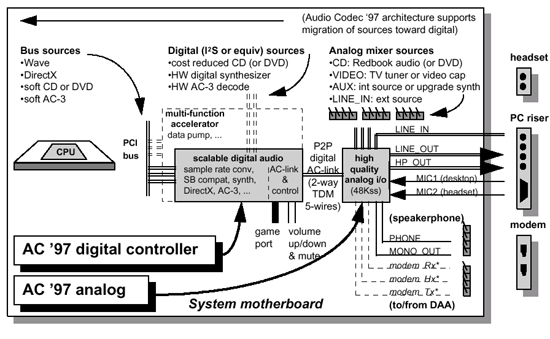VIA Apollo KX133 Athlon Chipset - Part 1
by Anand Lal Shimpi on February 7, 2000 11:51 PM EST- Posted in
- CPUs
We just mentioned that most of the KX133 design is “borrowed” from previous VIA chipsets, and the first example of that is the VT82C686A (commonly known as the 686A) South Bridge.
The 686A was first introduced on the Apollo Pro 133 chipset but is referred to as an option on the old Apollo Pro, a P6 chipset, as VIA’s Super South Bridge, this of course being an improvement over the 596B regular South Bridge. The 686A has been paired up with the 693 North Bridge for use with the Apollo Pro+, again with the 693A North Bridge for the Apollo Pro 133, and once again with the 694X North Bridge of the Apollo Pro 133A.
The flexibility of VIA’s North/South bridge setup is one reason they have kept it around for so long, and it has allowed them to use the 686A on their two Super7 chipsets, the MVP3 and the MVP4.
On the Athlon side of things, the 686A was the replacement South Bridge for the AMD 756 in designs that implemented the AMD 750 chipset. Now, the 686A is back once again with the Apollo KX133 chipset. As you can see, the 686A has been around for quite some time, and thus it didn’t take much effort for VIA to use it as the South Bridge of the KX133 chipset.
The 0.35-micron, 352-pin 686A remains unmodified from its original introduction and use on the P6 chipsets, and thus the specs remain the same. Let’s discuss the benefits of each one of these features to see what they actually accomplish:
· Inter-operable with VIA and other Host-to-PCI Bridges – As we just finished discussing, the fact of the matter is that the 686A can be used on a number of VIA chipset implementations, thus helping to keep costs down since VIA only has to manufacture one chip that can be implemented on a number of motherboard designs.
· Integrated PCI-to-ISA Bridge – This feature, present on the now old Intel piix4 and piix4e South Bridges but absent on the i820 and i810(E) chipsets, allows for the implementation of ISA slots on a motherboard that uses the 686A without having to use an external PCI-to-ISA Bridge. This helps save PCB space and cut costs. On the reverse side of things, ISA slots are quickly dying so this feature is becoming less of a necessity.
· Ultra ATA 33/66 PCI EIDE Controller – Just recently, Ultra ATA 33 has began to be saturated by the latest 7200 RPM IDE hard drives, so Ultra ATA 66 support is definitely a desired feature. While Intel is supposed to announce ATA-100 support in the near future, it will be a while before hard drives saturate the 66MB/s peak transfer rates of the Ultra ATA 66 specification.
· Integrated Super I/O Controller – Unique to the 686A, the integrated Super I/O controller takes care of all of the basic I/O needs of a motherboard. It provides the serial, IR, and parallel ports as well as the Floppy Disk Controller for the motherboard. Why is this so special? Well, currently no Intel chipset has these features integrated into any part of the chipset, meaning they have to resort to an external I/O controller to provide these functions. This external controller not only occupies PCB area on the motherboard it also adds the cost of another chip to the price of the motherboard. This is a feature the AMD 756 South Bridge does not support, one reason why many motherboard manufacturers chose to go with the 686A over the AMD 756 in their Athlon motherboard implementations.
· AC’97 & MC’97 Support – KX133 motherboards that take advantage of the Audio Codec ’97 support of the 686A South Bridge will feature an AC’97 controller placed on the motherboard that drives an integrated audio output while supporting the use of the AMR (Audio Modem Riser) slot for higher quality audio or modem support. The reason for the use of the AMR slot is to place the more sensitive components on an AMR slot so that motherboard manufacturers don’t have to increase the production time of their products because of the certification required for sensitive analog components such as those on modems or higher quality audio devices. This is also why, in spite of the presence of the AMR slot, the motherboard manufacturers will go ahead and include audio inputs/outputs on the motherboard itself, so they don’t have to worry about the certification time required by an AMR card in order to ship their boards to OEMs with integrated sound.

Remember that these AC’97 controllers depend on the host CPU to do most of the work associated with their particular tasks, but because of this they add a negligible amount to the final cost of the motherboard.
· Integrated Hardware Monitoring – Once again, by integrating hardware monitoring onto the 686A South Bridge, VIA helps to cut motherboard manufacturing costs by removing yet another chip from the PCB. Most motherboards use an external chip to provide hardware monitoring functionality which takes up PCB space and adds the cost of the chip to the motherboard. The integrated hardware monitoring can monitor 5 voltages (including the voltage supplied to the 686A chip itself), three temperatures (including the temp of the 686A) and two fans.
· Universal Serial Bus Controller – The 686A’s USB controller goes one step above Intel’s current USB implementation by allowing support for up to 4 USB devices.
In the end, the 686A South Bridges helps to integrate three commonly external chips (I/O Controller, Hardware Monitoring Controller, and South Bridge) into one chip. This helps to bring the cost of motherboards using the 686A down to costs lower than what the AMD 756 implementations placed them at. So far so good from VIA.










0 Comments
View All Comments